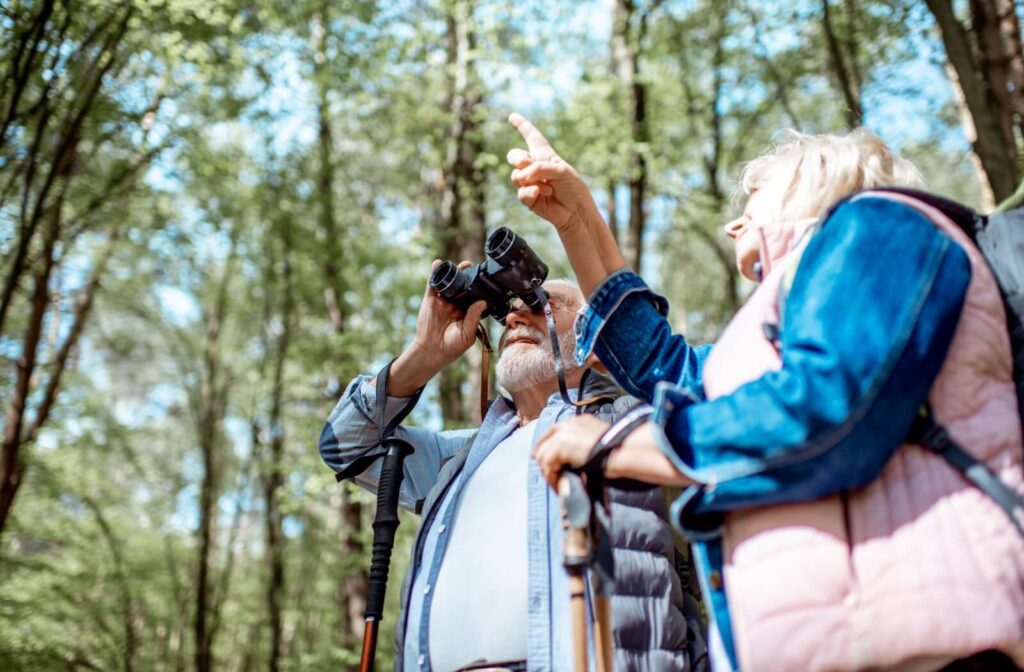Birdwatching isn’t just a way to pass the time—it’s a peaceful, rewarding hobby that invites you to slow down, tune into nature, and find joy in life’s quieter moments. Especially for older adults, it offers an ideal balance of mental engagement and physical activity without being overly strenuous.
This blog will show you how to set a routine, get equipped, where to look for birds near you, and explore the many benefits of birdwatching.
Whether you’re scanning treetops from your window or exploring a local nature trail, birdwatching opens the door to meaningful connection with the natural world.
The Mental & Physical Benefits of Birdwatching
Birdwatching is more than just a peaceful pastime—it’s a hobby with measurable health benefits for older adults. Research shows that spending time in nature and engaging in relaxing activities like birdwatching can significantly improve mental and physical well-being.
Spending time outdoors and connecting with wildlife can help reduce stress, anxiety, and depression. Birdwatching provides a gentle form of mindfulness, encouraging you to focus on the present moment and appreciate the small details of your surroundings.
Cognitive Engagement
Birdwatching keeps the brain active by encouraging memory, pattern recognition, and learning. Trying to identify new species or remember specific bird calls exercises the brain in enjoyable and low-pressure ways.
Physical Wellness
Even light physical activity can have long-term benefits for seniors. A short walk through a park or even standing at a window to observe feeders gets you moving in gentle, natural ways. According to the Centers for Disease Control and Prevention (CDC), older adults need about 150 minutes of moderate-intensity aerobic activity each week. Birdwatching can contribute to that goal, especially when paired with walking or hiking.
Moreover, studies from the University of Exeter show that exposure to green spaces is linked with reduced risk of chronic conditions like high blood pressure and heart disease.
Social Connection & Purpose
Birdwatching can be done solo, but it also lends itself well to shared experiences. Whether you join a group walk or share your sightings with a neighbor, the hobby encourages meaningful conversations and connections.
In essence, birdwatching is more than a hobby—it’s a gentle yet powerful way to support emotional balance, cognitive health, and physical activity, all while enjoying the beauty of the world just outside your window.

Starting a Birdwatching Routine
You don’t need a fixed schedule or grand plan to enjoy birdwatching. Just step outside, stay curious, and look up. Try keeping a regular journal of your sightings or joining a local birdwatching group.
Establishing a regular birdwatching routine—even something as simple as checking feeders each morning—can play a meaningful role in cognitive and emotional health. Studies have shown that consistent daily habits help improve memory, reduce stress, and create a sense of purpose, especially for older adults.
Get Equipped for Birdwatching
You don’t need to spend a lot to begin birdwatching, but a few essentials can make your outings more rewarding and comfortable.
Binoculars
A good pair of binoculars is the birdwatcher’s most important tool. Look for models with 8x or 10x magnification and an objective lens between 30mm and 42mm. These specifications offer a clear image while remaining lightweight—an important consideration for older adults.
Field Guide or Mobile App
Identifying birds is part of the fun. Traditional field guides like the Peterson Field Guide to Birds of North America are useful, especially when tailored to your region. You can also use apps like Merlin Bird ID, which help you identify birds based on appearance or song.
Comfortable Clothing
Dress for the weather, especially if you’ll be outside for a while. Supportive walking shoes, layered clothing, and sun protection (like a hat and sunscreen) are key. Don’t forget a refillable water bottle and perhaps a light backpack to carry your gear.
Notebook or Birdwatching App
Tracking your sightings can be a satisfying part of the experience. A simple notebook lets you record details like location, species, and behavior. Alternatively, apps like eBird allow you to log your observations digitally and contribute to community science.
Learn the Basics of Bird Identification
Bird identification can be both calming and mentally stimulating. Over time, you’ll begin to recognize patterns and become familiar with local species.
- Size and shape: Compare the bird to familiar species or objects. Is it small like a sparrow or large like a crow?
- Color and markings: Observe key features like wing bars, tail feathers, or distinct color patches.
- Sounds: Each bird has a unique call or song. Apps like BirdNET can help you match what you hear with a specific species.
- Behavior: Is the bird hopping, flying in quick bursts, or hovering? These traits help with identification too.
Start by learning common backyard species like robins, chickadees, and cardinals. With time, you’ll be able to spot and name more elusive birds too.
Where to Go Birdwatching
One of the best parts about birdwatching is that it can happen almost anywhere. Whether you prefer sitting by a sunny window or strolling through a local park, you’ll find feathered friends all around.
At Home Or In Your Senior Living Community
One of the easiest ways to begin birdwatching is right where you live. Setting up bird feeders, birdbaths, or planting native greenery can attract a wide variety of feathered visitors to your yard or outdoor space.
If you’re in a senior living community, speak with the staff about ways they can help support your new interest—many communities are happy to enhance outdoor areas for residents to enjoy nature.
Local Parks & Nature Trails
Community parks and walking paths are great for spotting birds. Look for areas with benches, shaded rest areas, and accessible walking trails. These features make outings more comfortable, especially for seniors.
Botanical Gardens & Arboretums
These beautifully maintained spaces often attract birds thanks to diverse plant life and quiet settings. Many also offer paved pathways and peaceful resting spots.
Wildlife Refuges
If you’re up for a short trip, try visiting a local wildlife refuge. Many are designed with accessibility in mind and include designated birdwatching stations and mobility-friendly paths.
Practice Good Birdwatching Etiquette
Respecting both wildlife and other nature lovers ensures that birdwatching remains a peaceful and sustainable activity.
- Keep noise low: Loud voices and sudden movements can scare birds away
- Stay on trails: Avoid trampling vegetation or disturbing habitats
- Don’t feed birds: Feeding wildlife can disrupt natural behaviors and harm their health
- Leave no trace: Pack out everything you bring in, including trash
- Be patient: Birdwatching is a slow and reflective hobby. Enjoy the stillness—it’s part of the experience
Stay Safe While Exploring
Birdwatching is a low-risk activity, but a few safety tips can help ensure your comfort and peace of mind.
- Check the weather: Dress appropriately and avoid going out in extreme conditions
- Bring a friend: Birdwatching is often more enjoyable—and safer—when shared
- Keep hydrated: Carry water, especially on warmer days or longer walks
- Travel light: Choose gear that won’t tire you out, and take regular breaks as needed
- Protect from sun exposure: Sunscreen, hats, and sunglasses can help prevent sunburn and eye strain
A Peaceful Hobby with Purpose
Birdwatching isn’t just about identifying species—it’s about staying present, enjoying nature, and finding small moments of joy. For older adults, it offers physical activity, mental stimulation, and emotional wellbeing. Whether you’re in it for the science, the solitude, or the sense of wonder, birdwatching can enrich your days in a quiet but powerful way.
At All American Assisted Living at Hanson, we believe in encouraging hobbies that enhance quality of life. Our community offers serene outdoor spaces, friendly walking paths, and opportunities for residents to connect over shared interests like birdwatching. If you’re looking for a place that supports an active and engaged lifestyle, we invite you to come visit us.
Contact us today to schedule a tour and see how our community can support your favorite pastimes—new and old.





